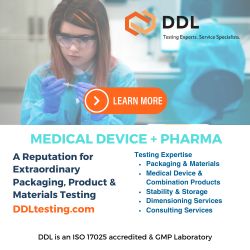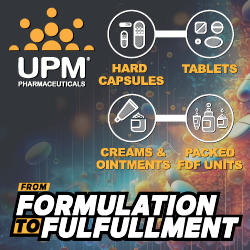Issue:May 2024
FORMULATION DEVELOPMENT - The Rising Need for an Integrated Approach to Small Molecules Drug Development
INTRODUCTION
Small molecules as therapeutic agents have played a significant role in the improvement of human health and well-being since the discovery and commercialization of molecules, such as Aspirin and Salvarsan over a century ago.1 They can broadly be defined as any organic compound with a low molecular weight (<1000 Daltons) and often have advantageous properties. These include the ability to be administered orally or to permeate via cell membranes to reach their intracellular targets, or not in the case of the blood-brain barrier where ingress may not be wanted.
Since the early days of drug development, the needs of the population have changed with regard to the medicines produced by the pharmaceutical industry. As the population ages, human behaviors shift and lifestyles change, so do the demands for effective treatments.
These changes pose a number of challenges. In living longer, we find that neurodegenerative conditions now pose an increased burden that requires effective treatment.2 As the demands of a changing society evolve and continue to act as a driver for the identification of novel small molecules, the roles and diversity of the available medicines will also change.
TRENDS IMPACTING SMALL MOLECULE DRUG DEVELOPMENT
Historically, it has been estimated that approximately 90% of all marketed drugs are represented by small molecules, demonstrating the opportunities that these candidates have provided.3 Advances in the technologies available to scientists have seen a rise in the application of biologics, such as antibody, cellular, and gene-based therapies.
The generation of new leads in the small molecule field remains a highly attractive challenge and one that is being met by the combined use of in silico screening tools and artificial intelligence (AI). These machine learning algorithms aim to significantly reduce the risk of failure and streamline the development process to provide structures of stable, druggable target molecules that are sensible from both a synthetic and a toxicological perspective.4 Although this is an exciting advancement in the complex process of developing new medicines, the need for the integration of more traditional “medicinal chemistry expertise” remains.
Throughout the past 20 years, there has been a shift in the demographic of those companies taking small molecules into later-stage clinical development. There has been growth in the number of small-to medium-size companies that hold on to their assets after Phase 1. Whilst the risk of possible failure remains high, the rewards are also more significant.
Another trend has been a growth in the number of products that are on an accelerated development pathway, due to the needs of a particular patient group being unmet by current therapeutics. This accelerated trajectory toward the clinic poses a burden on those planning for success as a significant amount of data is required early in the development timeline to support safe and rapid progression.
AN INCREASE IN CHALLENGING SMALL MOLECULES IN THE PIPELINE
Despite the integration of in silico modelling and AI approaches to design, there are an increasing number of small molecules entering development that exhibit challenges to their progression. These most commonly manifest as sub-optimal physicochemical characteristics, particularly inadequate or very low solubility, poor permeability, and unacceptable powder handling properties.
A rather succinct representation of this trend was provided over a decade ago by Amidon, who presented a graphic of immediate-release oral drugs by region as a percentage set against solubility.5 Most drugs for each region were those listed as practically insoluble (Figure 1).

Another graphic depicting the landscape for new chemical entities (NCEs) utilized by the biopharmaceutical classification system (BCS) to define the challenges being faced with at least 70% of those NCE’s falling within the BCS Class II category (Figure 2).6

THE NEED FOR AN EFFECTIVE STRATEGY TO IMPROVE SOLUBILITY & PERMEABILITY
Medicinal chemists may utilize in silico screening and AI to aid in the design of new structures. The pharmaceutical chemist has access to AI and screening tools to help with the prediction of solvate formation, propensity toward polymorphism and the likelihood of forming salt or cocrystal versions.7 AI and screening tools represent a growing part of the development toolbox and function to supplement the more traditional screening and manufacturing activities.
From a preformulation perspective, challenging molecules require a suitable strategy to be in place early in the drug substance’s life cycle. A simplified example of a training tool used in-house that describes this approach (a schematic relative to the BCS) is illustrated in Figure 3.

Thorough characterization and performance evaluation of a molecule with the route of administration in mind should answer the question: “What are the critical quality attributes (CQAs) that the selected solid form should provide?”
This question is continually challenged during development. For example, the acceptable and desirable attributes for a parenteral application may well differ significantly from that required for a respiratory indication.
A review of the approaches used to manipulate BCS Class II and IV candidates in Figure 3 illustrates that salt formation is a common route traditionally employed to improve many fundamental properties of a molecule. The well-cited reference – the Handbook of Pharmaceutical Salts – neatly defines that the selection of an optimal salt form for a novel drug candidate.9 Such studies are commonplace and can be extended to consider the benefits relative to:
- Polymorphism footprint (salt vs free API polymorphism)
- Morphology and powder flow (impact on size reduction/capsule filling/blend uniformity)
- Crystallinity/thermal stability
- Excipient compatibility and stability
- Recrystallization – further potential to control CQAs
UNIQUE APIS REQUIRE AN INTEGRATED APPROACH
There is no one size fits all when it comes to development. Compounds should be developed on a material basis, as screening and selection should never be formulaic. The entire process must be both iterative and pragmatic when required, and the ability to integrate the various aspects of pharmaceutical development, especially in the early phases, is ideal. A schematic of a phased approach is provided in Figure 4.

Given the pace of early phase development and the challenging nature of many NCEs, having a team of synthetic chemists integrated and coordinating with solid state experts enables rapid and successful progression. Taking the time to understand what is important from the beginning allows the construction of tailored programs.
One of the critical benefits of integration is easy access to material. As a synthetic process is optimized the impurity profile changes, and not always subtly. If the composition of the final product is brought to the forefront of the initial interactions between the chemist and the solid state scientist, early batches can be profiled with only a few mg cost in terms of spent API.
Ideally, this work starts to build a data set correlating solubility characteristics with form and impurity profiles. Solubility is typically gathered in water and processes applicable solvents during early phase chemical development. Solid form characterization normally includes (but is not limited to) crystallographic profile by XRPD and thermal properties.
For BCS class II and IV candidates, this solubility correlation can be of particular significance if an early amorphous batch was positioned toward the lower end of acceptable. Form change to a crystalline or to a more stable crystalline polymorph would likely reduce efficacy and require a more complex formulation strategy.
Another benefit of integration is the opportunity to profile each stage of the synthetic process. For highly insoluble molecules, it is likely that as you progress toward the final structure, solubility will drop, with work-up and isolation becoming more challenging. If this is combined with a propensity to polymorphism, control of the CQAs of intermediates, as well as the final product can be more than problematic.
Understanding form change throughout reduces the risk of failure at a later stage when more is at stake from a production perspective. Inorganic impurities that may become entrapped within the API and oligomers can be particularly troublesome. This is particularly evident during early phase batch isolation in which well-designed crystallizations are less common and precipitative methods are more often innocently applied before sufficient data is in hand.
This pragmatic approach to development should enable choices from an early stage and answer the question: “Will a salt be required, or is size reduction the initial option ahead of more complex strategies?” These decisions are critical and the integration of solid form with chemistry and early preformulation activities is a significant benefit to a risk-mitigating program.
Preformulation evaluations in particular are vital and more so in which a molecule has a pKa profile that makes salt formation likely but not without challenge. Having a well-characterized batch, solubility data can make the choice of salt or parent less of a challenge and for very little material cost.
A very useful reference to consider is that of Butler and Dressman who derived a Developability Classification System (DCS). Figure 5 illustrates this system in a schematic for oral immediate-release compounds and addresses the question of whether dose/solubility ratio, dissolution rate, and/or permeability would limit oral absorption of a drug. It can be used to help derive strategies for formulation and in turn the identification of the CQAs of the drug substance that should be the target deliverables.10 From the CDMO perspective, partnerships between internal working groups and the customer are essential.

THE FUTURE OF DRUG DEVELOPMENT RELIES ON AN INTEGRATED APPROACH
Small molecules continue to play a pivotal role in the supply of effective medicines to an ageing population and as tools to better understand the mechanism of interaction with their biological targets. Their complexity in terms of structure and material behavior makes development a continual challenge for those involved in deriving strategies that will deliver an effective drug product. Those molecules that are classified or predicted to sit within BCS class II and IV are of particular significance. However, realizing the benefits of integrating solid form and chemical development teams from an early phase, plus making use in silico and AI technology can provide a streamlined and risk-mitigating journey from the early phase to the clinic.
REFERENCES
- Hartmut, B.; Harter, M.; Hab, B.; Schmeck, C.; Baerfacker, L.; Drug Discovery Today, v27, No6, 2022, 1560-1574.
- Abbott, A.; Dementia: A problem for our age; Nature, 475, 2021, 52-54.
- Ngo, H.X.; Garneau-Tsodikan, S.; Med.Chem. Comm., v9(5), 2018, 757-758.
- Mullard, A.; Nature, v549, 2017, 445-447 / Gonzalez, M.G. et al.; Drug Discovery Today, v27, No6, 2022, 1661-1670
- G.L.Amidon et al; Mol Pharm 2006 Nov-Dec;3(6):631-43
- L.Benet, Pharm Res; 2005 Jan; 22(1):11-23
- Heng, T. et al; ACS Omega, 6, 2021, 15543-15550.
- Pharmaceutical Preformulation and Formulation, M.Gibson, Ed. Chapters 1-2; ISBN 1-57491-120-1.
- C.G. Wermuth and P.H. Stahl, “Introduction,” in Handbook of Pharmaceutical Salts: Properties, Selection and Use, P.H. Stahl and C.G. Wermuth, Eds. (Wiley–VCH, Weinheim, Germany, 2002).
- Butler, J.M; Dressman, J.B, J. Pharm. Sci.; Vol 99, 12, 2010.

Julian Northen graduated from the University of Newcastle upon Tyne with a 1st Class Honours degree and subsequently a PhD in Medicinal Chemistry and Anti-cancer Drug Design. This was followed by two post-doctoral positions, before a move from academia to Onyx. He has over 20 years of industrial experience in PR and D and is currently Solid State Manager at Onyx and is responsible for all solid form development, crystallization development, and preformulation activities.
Total Page Views: 4197













